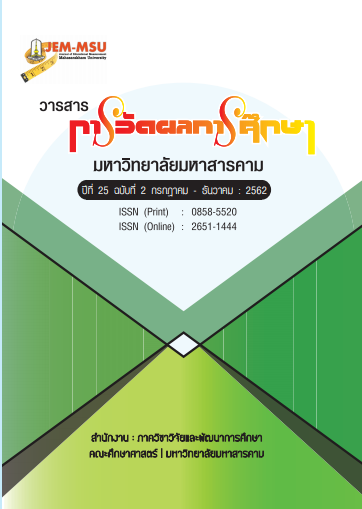Comparison of Mathematical Learning Achievement and Mathematical Problem Solving Ability on Sequences and Series for Grade 11 Students, Between Inductive Organizing of Learning Activities and the Traditional Organizing of Learning Activities
Main Article Content
Abstract
The purposes of this research were to: 1) develop inductive plans of organizing learning activities and traditional plans of organizing learning activities on the mathematical topic of Sequences and Series for grade 11 students to meet the efficiency criterion of 75/75; 2) study the effectiveness indexes of the inductive plans of organizing learning activities and traditional plans of organizing learning activities on the mathematical topic of Sequences and Series for grade 11 students; 3) compare of mathematical achievement and mathematical problem solving ability on the topic of Sequences and Series for grade 11 students between the inductive organizing of learning activities and traditional organizing of learning activities; 4) study learning retention on the topic of Sequences and Series for grade 11 students who learned with the inductive organizing of learning activities. The sample consisted of 70 grade 11 students from 2 classes in Bungkan School, Mueang Buengkan District, Buengkan Province in the 2nd semester of the academic year 2017, obtained through cluster random sampling. The research tools consisted of inductive plans of organizing learning activities and traditional plans of organizing learning activities on the mathematical topic of Sequences and Series for grade 11 students, a learning achievement test, a mathematical problem solving ability test, and a mathematics learning retention test. The statistics employed in data analysis were percentage, the mean, standard deviation and Hotelling T2 and t–test (dependent samples) were employed in the hypothesis testing.
The results of the study were as follows:
1. The inductive plans of organizing learning activities and the traditional plans of organizing learning activities on the mathematical topic of Sequences and Series for grade 11 students that had been constructed by the researcher had the efficiency of 79.74/77.52 and 77.93/76.48 respectively, and they met the 75/75 criterion.
2. The effectiveness indexes of the inductive organizing of learning activities and the traditional organizing of learning activities on the mathematical topic of Sequences and Series for grade 11 students were 0.6560 and 0.6378 respectively. It means that the students had the learning progress of 65.60 and 63.78 percent, respectively.
3. The grade 11 students who studied with the inductive organizing of learning activities had the mathematical achievement and mathematical problems solving ability on the topic of Sequences and Series higher than those who studied with the traditional organizing of learning activities, with statistical significance at the 0.05 level.
4. The grade 11 students who studied with the inductive organizing of learning activities on the topic of Sequences and Series had no difference in their immediate post-learning achievement and the 2-week post-learning achievement.
Article Details
The content and information contained in the published article in the Journal of Educational Measurement Mahasarakham University represent the opinions and responsibilities of the authors directly. The editorial board of the journal is not necessarily in agreement with or responsible for any of the content.
The articles, data, content, images, etc. that have been published in the Journal of Educational Measurement Mahasarakham University are copyrighted by the journal. If any individual or organization wishes to reproduce or perform any actions involving the entirety or any part of the content, they must obtain written permission from the Journal of Educational Measurement Mahasarakham University.
References
กระทรวงศึกษาธิการ. (2551). หลักสูตรแกนกลางการศึกษาขั้นพื้นฐานพุทธศักราช 2551. กรุงเทพฯ: โรงพิมพ์ คุรุสภาลาดพร้าว.
จิราภรณ์ ศิริทวี. (2541). เทคนิคการจัดกิจกรรมให้นักเรียนสร้างความรู้. วิชาการ 1(9), 37-52
ทิศนา แขมมณี. (2552). 14 วิธีสอนสาหรับครูมืออาชีพ. พิมพ์ครั้งที่ 9. กรุงเทพฯ: จุฬาลงกรณ์มหาวิทยาลัย.
. (2556). ศาสตร์การสอน : องค์ความรู้เพื่อการจัดกระบวนการเรียนรู้ที่มีประสิทธิภาพ.
พิมพ์ครั้งที่ 17. กรุงเทพฯ: สำนักพิมพ์แห่งจุฬาลงกรณ์มหาวิทยาลัย.
ธีนรันต์ สังหร. (2556). ผลของการจัดการเรียนรู้แบบอุปนัย-นิรนัยที่มีต่อผลสัมฤทธิ์ทางการเรียนวิชา คณิตศาสตร์ ความสามารถในการให้เหตุผลและความสามารถในการสื่อสารทางคณิตศาสตร์ เรื่อง สถิติของนักเรียนชั้นมัธยมศึกษาปีที่ 3. ปริญญานิพนธ์การศึกษามหาบัณฑิต, มหาวิทยาลัย
ศรีนครินทรวิโรฒ.
ปานทอง กุลนาถศิริ. (2552). สาระที่ควรเพิ่มและควรลดและข้อคิดการจัดกิจกรรมคณิตศาสตร์ในยุคปฏิรูป. กรุงเทพฯ: สถาบันส่งเสริมการสอนวิทยาศาสตร์และเทคโนโลยี.
พิมพ์พันธ์ เตชะคุปต์. (2545). “การเรียนแบบร่วมมือ”ในประมวลบทความการเรียนการสอนและการวิจัย ระดับมัธยมศึกษา. หน้า 1–15. กรุงเทพฯ: โรงพิมพ์จุฬาลงกรณ์มหาวิทยาลัย.
ไพรวัลย์ สงวนแก้ว. (2555). การพัฒนากิจกรรมการเรียนรู้แบบอุปนัย กลุ่มสาระการเรียนรู้คณิตศาสตร์ เรื่อง ความสัมพันธ์ระหว่างรูปเรขาคณิตสองมิติและสามมิติ ชั้นมัธยมศึกษาปีที่ 1. ปริญญาการศึกษา มหาบัณฑิต, มหาวิทยาลัยมหาสารคาม.
ยุพิน พิพิธกุล. (2545). การสอนคณิตศาสตร์. กรุงเทพฯ: คณะครุศาสตร์ จุฬาลงกรณ์มหาวิทยาลัย.
. (2546). การเรียนการสอนคณิตศาสตร์ยุคปฏิรูปการศึกษา. กรุงเทพฯ: บพิธการพิมพ์.
เยาวพา สาครเจริญ. (2555). การเปรียบเทียบผลสัมฤทธิ์ทางการเรียน ความสามารถด้านการคิดวิเคราะห์ และ เจตคติต่อการเรียนคณิตศาสตร์ เรื่อง ทศนิยมและเศษส่วน ชั้นมัธยมศึกษาปีที่ 1 ระหว่างการจัด กิจกรรมการเรียนรู้แบบอุปนัยกับการจัดการเรียนรู้แบบนิรนัย. ปริญญาการศึกษา มหาบัณฑิต, มหาวิทยาลัยมหาสารคาม.
ล้วน สายยศ และอังคณา สายยศ. (2543). เทคนิคการวิจัยทางการศึกษา. พิมพ์ครั้งที่3. กรุงเทพฯ: สุวีริยาสาส์น
วันทนีย์ กะตะศิลา. (2554). การพัฒนาทักษะการแก้โจทย์ปัญหาคณิตศาสตร์โดยใช้การจัดการเรียนรู้แบบ อุปนัยสาหรับนักเรียนชั้นประถมศึกษาปีที่ 3. ปริญญาการศึกษามหาบัณฑิต, มหาวิทยาลัยสุโขทัย -
ธรรมาธิราช. กรุงเทพฯ.
วิริยะ บุญยะนิวาสน์. (2537). มาพัฒนาการเรียนการสอนกันเถอะกลุ่มทักษะคณิตศาสตร์. วารสารประชากร ศึกษา, 44(11), 26-32.
วีณา ประชากูล และประสาท เนืองเฉลิม. (2554). รูปแบบการเรียนการสอน. พิมพ์ครั้งที่ 2. มหาสารคาม: สำนักพิมพ์มหาวิทยาลัยมหาสารคาม.
ศิริพร ไชยศรี. (2559). ผลการจัดกิจกรรมการเรียนรู้ เรื่อง ตรรกศาสตร์ โดยใช้การสอนแบบอุปนัยเพื่อสร้าง ความคิดรวบยอดทางคณิตศาสตร์ ของนักเรียนชั้นมัธยมศึกษาปีที่ 4 โรงเรียนเทพา จังหวัดสงขลา. ปริญญาวิทยาศาสตรมหาบัณฑิต สาขาวิชาคณิตศาสตรศึกษา คณะวิทยาศาสตร์ มหาวิทยาลัยบูรพา.
สถาบันการทดสอบทางการศึกษาแห่งชาติ (องค์การมหาชน). (2559). ประกาศและรายงานผลโอเน็ต,
24 มีนาคม 2560. https://www.onetresult.niets.or.th/AnnouncementWeb/login.aspx/
สถาบันส่งเสริมการสอนวิทยาศาสตร์และเทคโนโลยี. (2551). คู่มือครูสาระการเรียนรู้พื้นฐานคณิตศาสตร์
กลุ่มสาระการเรียนรู้คณิตศาสตร์ชั้นมัธยมศึกษาปีที่ 4. พิมพ์ครั้งที่ 6. กรุงเทพฯ: โรงพิมพ์ สกสค. ลาดพร้าว.
สมนึก ภัททิยธนี. (2549). การวัดผลการศึกษา. พิมพ์ครั้งที่ 3. กาฬสินธุ์: โรงพิมพ์ประสานการพิมพ์.
สิริพร ทิพย์คง. (2533). ทฤษฎีและวิธีสอนคณิตศาสตร์. กรุงเทพฯ: ภาควิชาการศึกษา. คณะศึกษาศาสตร์ มหาวิทยาลัยเกษตรศาสตร์. ถ่ายเอกสาร.
. (2545). หลักสูตรและการสอนคณิตศาสตร์. กรุงเทพฯ: พัฒนาคุณภาพวิชาการ (พว).
สุนันทา สุนทรประเสริฐ. (ม.ป.ป). การสร้างแบบฝึก. กรุงเทพฯ..
สุพัตรา ภูหงษ์สูง. (2550). การพัฒนาแผนการจัดการเรียนรู้กลุ่มสาระการเรียนรู้คณิตศาสตร์ เรื่อง จำนวน เชิงซ้อน ชั้นมัธยมศึกษาปีที่ 5 โดยการสอนแบบอุปนัยและแบบนิรนัยประกอบการใช้เทคนิค STAD. ปริญญาการศึกษามหาบัณฑิต, มหาวิทยาลัยมหาสารคาม.
สุวิทย์ มูลคำและอรทัย มูลคำ. (2547). 19 วิธีจัดการเรียนรู้: เพื่อพัฒนาความรู้และทักษะ. พิมพ์ครั้งที่ 5. กรุงเทพฯ: ภาพพิมพ์.
อรนุช ศรีสะอาด และคณะ. (2549). การวัดและประเมินผลการศึกษา. กาฬสินธุ์ : ประสานการพิมพ์
อรรคพล คำภู. (2542). ได้ทำการศึกษาการเปรียบเทียบผลสัมฤทธิ์ทางการเรียนและความคงทนในการเรียนรู้ วิชาคณิตศาสตร์ ของนักเรียนชั้นมัธยมศึกษาปีที่ 2 ที่ได้รับการสอนด้วยวิธีการสอนแบบอุปนัยวิธีการ สอนแบบนิรนัย และวิธีการสอนตามคู่มือครู. ปริญญาการศึกษามหาบัณฑิต, มหาวิทยาลัย
ศรีนครินทรวิโรฒ.
Lovett ,H.T. (1978). “The Effect of Violating the Assumption of Edual Item Means in Estimating the Livingston Coefficient”, Educational and Psychological Measurement. 38: 239-251.
Whitney, D. R. and D. L. Sabers. (1970). “Improving Essay Examinations III. Use of Item Analysis”, Technical Bulletin 11. Mimeographed. (Iowa City: University Evaluation and
Examination Service)


